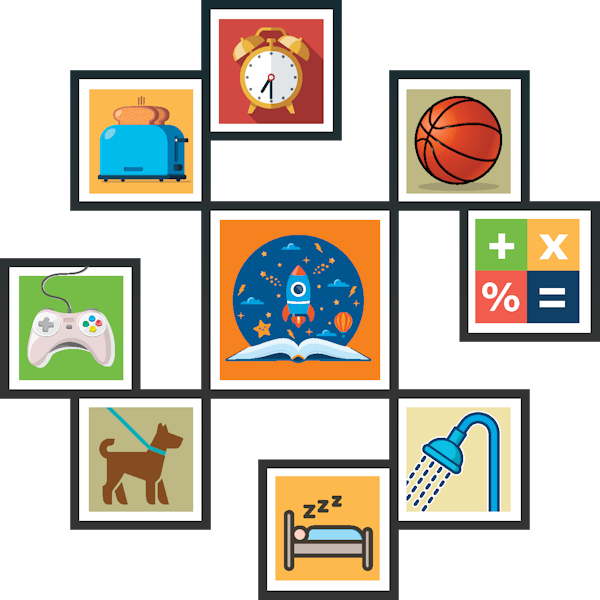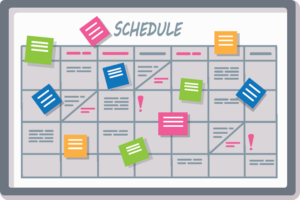School’s Out: Give Summer Some Structure
Carey Heller, PsyD
Download PDF
Summer is often thought of as a more relaxed time of year,
giving kids a break from school and the daily routines that can be stressful and sometimes unpleasant. If you’re parenting a child with ADHD, one of your biggest challenges may be helping your child to function successfully during the summer and not regress to a point where it is difficult to get back on track with the new school year.
Numerous strategies can help your child thrive this summer and prepare for the new school year. Each child’s needs vary, so these strategies might need modification based on factors specific to your child.
Structure and planning
It is important to maintain the basic structure of important self-care routines—consistent bedtime and wakeup time, regulation of technology use, getting physical activity, and other similar things that can be especially important for children who have ADHD. The daily routine can certainly be adjusted slightly; bedtime, for example, could be thirty minutes later since the child does not need to get up as early. Adjustments could be also made to accommodate special events or a family vacation away from home. The main principle for parents to keep in mind is to minimize disruptions to routines that work well, and if needed create modified versions for the summer months.

When your child spends a week or more away from structured activities—to attend a camp or summer program, for example—working with them to create their own schedule for each day can be immensely helpful. For some kids, doing this with even one day off may be highly beneficial. This enables them to maintain more structure (consistent times for going to bed, getting up, and eating meals) and function better with self-care.
In addition, helping your child plan activities they want to do at home each day (or when feasible outside the home) can help them learn how to structure their time themselves and keeps them better entertained. This also allows them to be more likely to incorporate things they want to do or should do (such as practicing an instrument or specific skills for a sport) and follow through on completing these activities each day. If there are specific tasks or chores they must do, it is important that they learn to add them to their plan as well. It is okay to have some blocks of time where specific activities are not planned, which gives your child an opportunity to not be on a set schedule the entire day while still maintaining enough structure to thrive.
Here is an example of a planned schedule.
| 7:30 AM | Get up with alarm. |
| 7:40 AM | Get dressed. |
| 7:45 AM | Eat breakfast that you make yourself. |
| 8 AM | Practice violin for twenty minutes. |
| 8:20 AM | Read one chapter of summer reading book. |
| About 8:45/9AMish | Play basketball in backyard for thirty minutes or get in some sort of other physical activity. |
| Around 9:15 to 9:30 AMish until 11 AM | Free time with electronics. |
| 11 AM to about 11:30 AM | Do chores. |
| About 11:30 AM to 12 PM | Work on math packet for thirty minutes. |
| Around 12 PM to 1 PM | Eat lunch and relax off screens. |
| About 1 PM to 3 PM | Free time on or off screens. |
| 3 PM to 3:30 PM | Walk dog with parent. |
| 3:30 PM to 5 PM | Go to pool with parent. |
| 5:15 to 5:45 PMish | Shower. |
| 6 PM to 7 PM | Help make dinner and eat. |
| 7 PM to 8 PM | Free time and/or time with family. |
| 8 PM to 8:15 PM | Wash up for bed. |
| 8:15 PM | Get into bed, read, and go to sleep. |
Monitoring your child while you work
 Like many parents today, you may find yourself having to work from home while your children are home during the summer. If they are older, your kids or teens may be home by themselves while you are at work. Having a set schedule as discussed above can help keep kids entertained and make it easier for them to follow through on doing things as a starting point. Other strategies that work well include planning break times to check on your kids and even doing activities with them between meetings. It’s also effective to let your kids know your schedule, so they can be aware of when it is okay to interrupt you versus when they should only contact you if it’s a true emergency.
Like many parents today, you may find yourself having to work from home while your children are home during the summer. If they are older, your kids or teens may be home by themselves while you are at work. Having a set schedule as discussed above can help keep kids entertained and make it easier for them to follow through on doing things as a starting point. Other strategies that work well include planning break times to check on your kids and even doing activities with them between meetings. It’s also effective to let your kids know your schedule, so they can be aware of when it is okay to interrupt you versus when they should only contact you if it’s a true emergency.
If you are working from home, it would be helpful to set up a visual system, such as hanging your schedule for the day on a whiteboard outside the door of the room where you work. You could also have a sign that you flip when you go into meetings (to red, for example) that otherwise indicates you are available if necessary (perhaps to green). For this system to work well, you might need to use a reminder or other method to remember to switch the sign.
Set up an agreed-upon communication system for your kids to use if they need to contact you while you are working. For example, they can text or email you. Elementary school-aged kids who don’t have a phone could use an iPad, Chromebook, or other device to send a message through some sort of agreed-upon platform. Whatever method you and your children agree on, you’ll be able to see the message and respond discreetly when necessary (during meetings, for example). Then, when you get to a good stopping point to take a break, you can address the item as needed.
Flexibility within reason
A child’s summer schedule may vary a lot from week to week, based on whether they have organized activities or nothing formal planned. Day trips, vacations, and other kinds of activities can derail some of the structure of the routines noted above. Given this, the idea of flexibility is included as its own strategy. Using flexibility in a controlled, calculated, and planned manner can enable your child (and you) to not miss out on fun things, cope effectively with unexpected changes in your schedule, and stay on track with good self-care. Choose sparingly when to deviate from a given routine and put parameters in place to prevent modifications from having long-term negative ramifications.
Let’s look at an example. If your family got invited to a barbeque at a friend’s house and it would end after your child’s bedtime, how would you handle it? Obviously, you could choose not to go or to go and leave early. Another option might be to go and let your kids stay up late in this rare instance. To minimize negative ramifications, you could have the kids take time to rest in the afternoon beforehand to prevent a meltdown in the evening. You could make sure the schedule works to let them sleep a bit longer the following morning and have them go to bed at the normal time the next night, thus getting right back on track. Some kids are more sensitive to changes in sleep routine than others, so you have to decide what events are worth adjusting the routine.
While it can be a great time for kids to take a breather and try new things, summer breaks can be problematic. For children and teens with ADHD, including enough of a routine is essential for ideal functioning during the summer and often makes it easier to acclimate to the new school year.
Wishing you a wonderful summer filled with fun, enough structure to maintain basic routines, and opportunities for growth.
 Carey A. Heller, PsyD, is a licensed psychologist based in Maryland. He specializes in the evaluation and treatment of ADHD and executive function issues. Learn more at hellerpsychologygroup.com. The coordinator for the Montgomery County chapter of CHADD, Dr. Heller also serves as chair of the editorial advisory board for Attention magazine.
Carey A. Heller, PsyD, is a licensed psychologist based in Maryland. He specializes in the evaluation and treatment of ADHD and executive function issues. Learn more at hellerpsychologygroup.com. The coordinator for the Montgomery County chapter of CHADD, Dr. Heller also serves as chair of the editorial advisory board for Attention magazine.
Other Articles in this Edition
How to Shift Black-and-White Thinking
ADHD and College: Experiences and Supports
Putting the Skids on Summer Slide
School’s Out: Give Summer Some Structure
Apps Can Help Girls Manage When Hormones Affect ADHD Symptoms
Uniting in Understanding: The Role of Peer Support in ADHD Management
